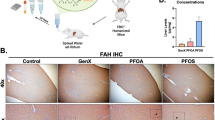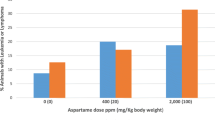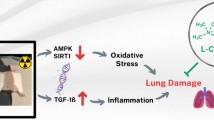Abstract
Rubiadin (Rub) is a genotoxic component of madder color (MC) that is extracted from the root of Rubia tinctorum L. MC induces renal tumors and preneoplastic lesions that are found in the proximal tubule of the outer stripe of the outer medulla (OSOM), suggesting that the renal carcinogenicity of MC is site specific. To clarify the involvement of Rub in renal carcinogenesis of MC, we examined the distribution of Rub in the kidney of male gpt delta rats that were treated with Rub for 28 days. We used desorption electrospray ionization quadrupole time-of-flight mass spectrometry imaging (DESI-Q-TOF-MSI), along with the histopathological analysis, immunohistochemical staining, and reporter gene mutation assays of the kidney. DESI-Q-TOF-MSI revealed that Rub and its metabolites, lucidin and Rub-sulfation, were specifically distributed in the OSOM. Histopathologically, karyomegaly characterized by enlarged nuclear and microvesicular vacuolar degeneration occurred in proximal tubule epithelial cells in the OSOM. The ɤ-H2AX- and p21-positive cells were also found in the OSOM rather than the cortex. Although dose-dependent increases in gpt and Spi− mutant frequencies were observed in both the medulla and cortex, the mutant frequencies in the medulla were significantly higher. The mutation spectra of gpt mutants showed that A:T-T:A transversion was predominant in Rub-induced gene mutations, consistent with those of MC. Overall, the data showed that the distribution of Rub and its metabolites resulted in site-specific histopathological changes, DNA damage, and gene mutations, suggesting that the distribution of genotoxic components and metabolites is responsible for the site-specific renal carcinogenesis of MC.






Similar content being viewed by others
References
Bi X, Slater DM, Ohmori H, Vaziri C (2005) DNA polymerase k is specifically required for recovery from the benzo[a]pyrene-dihydrodiol epoxide (BPDE)-induced S-phase checkpoint. J Biol Chem 280:22343–22355. https://doi.org/10.1074/jbc.M501562200
Blömeke B, Poginsky B, Schmutte C, Marquardt H, Westendorf J (1992) Formation of genotoxic metabolites from anthraquinone glycosides, present in Rubia tinctorum L. Mutat Res 265:263–272. https://doi.org/10.1016/0027-5107(92)90055-7
Boiteux S, Guillet M (2004) Abasic sites in DNA: repair and biological consequences in Saccharomyces cerevisiae. DNA Repair 3:1–12. https://doi.org/10.1016/j.dnarep.2003.10.002
Brown JP, Dietrich PS (1979) Mutagenicity of anthraquinone and benzanthrone derivatives in the Salmonella/microsome test: activation of anthraquinone glycosides by enzymic extracts of rat cecal bacteria. Mutat Res 66:9–24. https://doi.org/10.1016/0165-1218(79)90003-X
Hibi D, Suzuki Y, Ishii Y, Jin M, Watanabe M, Sugita-Konishi Y, Yanai T, Nohmi T, Nishikawa A, Umemura T (2011) Site-specific in vivo mutagenicity in the kidney of gpt delta rats given a carcinogenic dose of ochratoxin A. Toxicol Sci 122:406–414. https://doi.org/10.1093/toxsci/kfr139
Inoue K, Yoshida M, Takahashi M, Shibutani M, Takagi H, Hirose M, Nishikawa A (2009a) Induction of kidney and liver cancers by the natural food additive madder color in a two-year rat carcinogenicity study. Food Chem Toxicol 47:184–191. https://doi.org/10.1016/j.fct.2008.10.031
Inoue K, Yoshida M, Takahashi M, Fujimoto H, Ohnishi K, Nakashima K, Shibutani M, Hirose M, Nishikawa A (2009b) Possible contribution of rubiadin, a metabolite of madder color, to renal carcinogenesis in rats. Food Chem Toxicol 47:752–759. https://doi.org/10.1016/j.fct.2009.01.003
Inoue K, Yoshida M, Takahashi M, Fujimoto H, Shibutani M, Hirose M, Nishikawa A (2009c) Carcinogenic potential of alizarin and rubiadin, components of madder color, in a rat medium-term multi-organ bioassay. Cancer Sci 100:2261–2267. https://doi.org/10.1111/j.1349-7006.2009.01342.x
Ishii Y, Nakamura K, Mitsumoto T, Takimoto N, Namiki M, Takasu S, Ogawa K (2022) Visualization of the distribution of anthraquinone components from madder roots in rat kidneys by desorption electrospray ionization-time-of-flight mass spectrometry imaging. Food Chem Toxicol 161:112851. https://doi.org/10.1016/j.fct.2022.112851
Ishii Y, Matsushita K, Kuroda K, Yokoo Y, Kijima A, Takasu S, Kodama Y, Nishikawa A, Umemura T (2015) Acrylamide induces specific DNA adduct formation and gene mutations in a carcinogenic target site, the mouse lung. Mutage 30:227–235. https://doi.org/10.1093/mutage/geu062
Ishii Y, Takasu S, Kuroda K, Matsushita K, Kijima A, Nohmi T, Ogawa K, Umemura T (2014) Combined application of comprehensive analysis for DNA modification and reporter gene mutation assay to evaluate kidneys of gpt delta rats given madder color or its constituents. Anal Bioanal Chem 406:2467–2475. https://doi.org/10.1007/s00216-014-7621-2
Ishii Y, Okamura T, Inoue T, Fukuhara K, Umemura T, Nishikawa A (2010) Chemical structure determination of DNA bases modified by active metabolites of Lucidin-3-O-primeveroside. Chem Res Toxicol 23:134–141. https://doi.org/10.1021/tx900314c
Kastan MB (2008) DNA damage responses: mechanisms and roles in human disease. 2007. G.H.A. Clowes memorial award lecture. Mol Cancer Res 6:517–524. https://doi.org/10.1158/1541-7786.MCR-08-0020
Kawasaki Y, Goda Y, Yoshiura K (1992) The mutagenic constituents of Rubia tinctorum. Chem Pharm Bull 40:1504–1509. https://doi.org/10.1248/cpb.40.1504
Koepsell H (2020) Organic cation transporters in health and disease. Pharmacol Rev 72:253–319. https://doi.org/10.1124/pr.118.015578
Masumura K, Sakamoto Y, Ikeda M, Asami Y, Tsukamoto T, Ikehata H, Kuroiwa Y, Umemura T, Nishikawa A, Tatematsu M, Ono T, Nohmi T (2011) Antigenotoxic effects of p53 on spontaneous and ultraviolet light B-induced deletions in the epidermis of gpt delta transgenic mice. Environ Mol Mutagen 52:244–252. https://doi.org/10.1002/em.20610
Masumura K, Matsui M, Kato M, Horiya N, Ueda O, Tanabe H, Yamada M, Suzuki H, Sofuni T, Nohmi T (1999) Spectra of gpt mutations in ethylnitrosourea-treated and untreated transgenic mice. Environ Mol Mutagen 34:1–8. https://doi.org/10.1002/(sici)1098-2280(1999)34:1%3c1::aid-eml%3e3.0.co;2-p
MHLW (Ministry of Health, Labour and Welfare of Japan) (1995) List of existing food additives. Foods Food Ingred (editorial) 166:93–101 ((in Japanese))
Nohmi T (2016) Past, present and future directions of gpt delta rodent gene mutation assays. Food Saf 4:1–13. https://doi.org/10.14252/foodsafetyfscj.2015024
Nohmi T, Suzuki T, Masumura K (2000) Recent advances in the protocols of transgenic mouse mutation assays. Mutat Res 455:191–215. https://doi.org/10.1016/S0027-5107(00)00077-4
Okamura T, Ishii Y, Suzuki Y, Inoue T, Tasaki M, KodamaY NT, Mitsumori K, Umemura T, Nishikawa A (2010) Effects of co-treatment of dextran sulfate sodium and MelQx on genotoxicity and possible carcinogenicity in the colon of p53-deficient mice. J Toxicol Sci 35:731–741. https://doi.org/10.2131/jts.35.731
Poginsky B, Westendorf J, Blömeke B, Marquardt H, Hewer A, Grover PL, Philips DH (1991) Evaluation of DNA-binding activity of hydroxyanthraquinones occurring in Rubia tinctorum L. Carcinogenesis 12:1265–1271. https://doi.org/10.1093/carcin/12.7.1265
Rached E, Hard GC, Blumbach K, Weber K, Draheim R, Lutz WK, Ozden S, Steger U, Dekant W, Mally A (2007) Ochratoxin A: 13-week oral toxicity and cell proliferation in male F344/N rats. Toxicol Sci 97:288–298. https://doi.org/10.1093/toxsci/kfm042
Scully R, Xie A (2013) Double strand break repair functions of histone H2AX. Mutat Res 750:5–14. https://doi.org/10.1016/j.mrfmmm.2013.07.007
Sherr CJ, Roberts JM (1995) Inhibitors of mammalian G1 cyclin-dependent kinases. Genes Dev 9:1149–1163. https://doi.org/10.1101/gad.9.10.1149
Stoeckli M, Chaurand P, Hallahan DE, Caprioli RM (2001) Imaging mass spectrometry: a new technology for the analysis of protein expression in mammalian tissues. Nat Med 7:493–496. https://doi.org/10.1038/86573
Summers KC, Shen F, Sierra Potchanant EA, Phipps EA, Hickey RJ, Malkas LH (2011) Phosphorylation: the molecular switch of double-strand break repair. Int J Proteomics 2011:373816. https://doi.org/10.1155/2011/373816
Takasu S, Ishii Y, Namiki M, Nakamura K, Mitsumoto T, Takimoto N, Nohmi T, Ogawa K (2023) Comprehensive analysis of the general toxicity, genotoxicity, and carcinogenicity of 3-acetyl-2,5-dimethylfuran in male gpt delta rats. Food Chem Toxicol 172:113544. https://doi.org/10.1016/j.fct.2022.113544
Tchou WW, Rom WN, Tchou-Wong KM (1996) Novel form of p21 (WAF1/ CIP1/SDI1) protein in phorbol ester-induced G2/M arrest. J Biol Chem 271:29556–29560. https://doi.org/10.1074/jbc.271.47.29556
Westendorf J, Poginsky B, Marquardt H, Groth G, Marquardt H (1988) The genotoxicity of lucidin, a natural component of Rubia tinctorum L. and lucidinethylether, a component of ethanolic rubia extracts. Cell Biol Toxicol 4:225–239. https://doi.org/10.1007/BF00119248
World Health Organization (WHO) (2006) Transgenic animal mutagenicity assays environmental health criteria. WHO, Geneva, p 233
Yasui Y, Takeda N (1983) Identification of a mutagenic substance, in Rubia tinctorum L. (madder) root, as lucidin. Mutat Res 121:185–190. https://doi.org/10.1016/0165-7992(83)90201-4
Zhang J, Wang H, Fan Y, Yu Z, You G (2021) Regulation of organic anion transporters: role in physiology, pathophysiology, and drug elimination. Pharmacol Ther 217:107647. https://doi.org/10.1016/j.pharmthera.2020.107647
Acknowledgements
The authors thank Ms. Ayako Saikawa and Ms. Yoshimi Komatsu for expert technical assistance in processing histological materials. This study was supported by JSPS KAKENHI Grant Number 19K12349.
Funding
This study was funded by Japan Society for the Promotion of Science,19K12349,Yuji Ishii.
Author information
Authors and Affiliations
Contributions
TM contributed to investigation, writing-original draft, and visualization. YI was involved in investigation, conceptualization, methodology, writing––review and editing, and funding acquisition. NT, ST, MN, and TN were responsible for investigation and resources. TU contributed to conceptualization. KO was involved in conceptualization, methodology, writing––review and editing, and supervision.
Corresponding author
Ethics declarations
Conflict of interest
The authors declare no potential conflicts of interest with respect to the research, authorship, and/or publication of this article. Tatsuya Mitsumoto is an employee of Bozo Research Center Inc. (Shizuoka, Japan). Norifumi Takimoto is an employee of Ono Pharmaceutical Co. Ltd. (Osaka, Japan).
Additional information
Publisher's Note
Springer Nature remains neutral with regard to jurisdictional claims in published maps and institutional affiliations.
Supplementary Information
Below is the link to the electronic supplementary material.
Rights and permissions
Springer Nature or its licensor (e.g. a society or other partner) holds exclusive rights to this article under a publishing agreement with the author(s) or other rightsholder(s); author self-archiving of the accepted manuscript version of this article is solely governed by the terms of such publishing agreement and applicable law.
About this article
Cite this article
Mitsumoto, T., Ishii, Y., Takimoto, N. et al. Site-specific genotoxicity of rubiadin: localization and histopathological changes in the kidneys of rats. Arch Toxicol 97, 3273–3283 (2023). https://doi.org/10.1007/s00204-023-03610-4
Received:
Accepted:
Published:
Issue Date:
DOI: https://doi.org/10.1007/s00204-023-03610-4




